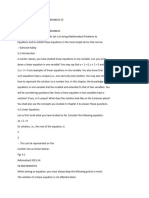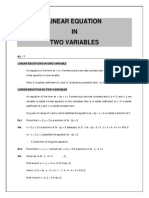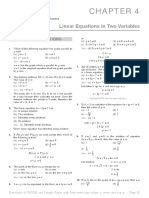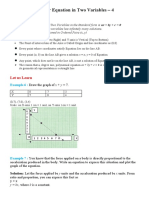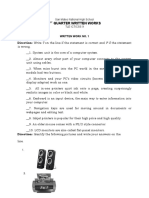Linear Equation in Two Variables – 3
We have learnt:
The Graph of Linear Equation in Two Variables is a straight line in the Cartesian
Coordinate Plane
The Linear Equation in Two Variables in the Standard form is ax + by + c = 0
a linear equation in two variables has infinitely many solutions.
The Solutions are mentioned in Ordered Pairs (x, y)
(x, y) ≠(y, x)
Let us Learn
Exercise 4.2
2. Write four solutions for each of the following equations:
(i) 2x + y = 7 (ii) πx + y = 9 (iii) x = 4y
2x + y = 7 πx + y = 9 x = 4y
Let x = 1 Let y = 1 Let y = 2
2(1) + y = 7 πx + 1 = 9 x = 4(2)
y=7-2 πx = 9 – 1 x=8
y=5 πx = 8 (8,2)
(1,5) 8
x=
π Let y = 1
Let y = 4 8 x = 4(1)
2x + 4 = 7 ( , 1) x=4
π
2x = 7 - 4 (4,1)
2x = 3 Let x = 0
3 π(0) + y = 9 Let x = 6
x=
2 0+y=9 6 = 4y
3 y=9 6
( , 4) y=
2 (0,9) 4
3
Let y = 5 Let y = 2 y=
2
2x + 5 = 7 πx + 2 = 9
2x = 7 – 5 πx = 9 – 2 3
(6, )
2x = 2 πx = 7 2
x=1 7
x= Let y = 4
(1,5) π
7 x = 4(4)
Let x = 0 ( , 2) x = 16
π
2(0) + y = 7 (16,4)
0+y=7 Let y = 0
y=7 πx + 0 = 9
(0,7) πx= 9
9
x=
π
9
( , 0)
π
�3. Check which of the following are solutions of the equation x – 2y = 4 and which are not:
(i) (0, 2) (ii) (2, 0) (iii) (4, 0) (iv)( √ 2 , 4 √ 2) (v) (1, 1)
x – 2y = 4 for (0, 2) x – 2y = 4 for (2, 0) x – 2y = 4 for (4, 0) x – 2y = 4 for x – 2y = 4 for (1, 1)
LHS = x – 2y LHS = x – 2y LHS = x – 2y ( √ 2 , 4 √ 2) LHS = x – 2y
= 0 – 2 (2) = 2 – 2(0) = 4 – 2(0) LHS = x – 2y = 1 – 2(1)
= -4 =2–0 =4–0 = √ 2 - 2(4√ 2 ¿ =1 - 2
≠ RHS = 2 = 4 = √ 2 - 8√ 2 =-1
∴ Not a solution ≠ RHS = RHS = -7√ 2 ≠ RHS
∴ Not a solution It is a solution ≠ RHS ∴ Not a solution
∴ Not a solution
4. Find the value of k, if x = 2, y = 1 is a solution of the equation 2x + 3y = k.
2x + 3y = k.
2(2) + 3(1) = k
k=4+3
k=7
Graph of a Linear Equation in Two Variables
Plotting Graph:
A normal Graph sheet has 20 blocks of 1 cm horizontally (Right to Left) and 26 blocks of 1 cm Vertically
(Top to Bottom)
There are two Axis in Graph
X-axis is horizontal (Left to Right) and Y-axis is Vertical (Top to Bottom)
The Point of intersection of the Axis is Called Origin and has coordinates as (0,0)
The solutions of the linear equation in Example 3, namely, x + 2y = 6
X 2 4 0
Y 2 1 3
(2,2) , (4,1) , (0,3)
Scale: on X – Axis 1 cm = 1 Unit, On Y – Axis 1 cm = 1 Unit
� Y
4
0 1 2 3 4 5 X
Our observations:
Every point whose coordinates satisfy Equation lies on the line AB.
Every point (a, b) on the line AB gives a solution x = a, y = b of Equation
Any point, which does not lie on the line AB, is not a solution of Equation
The reason that a, degree one, polynomial equation ax + by + c = 0 is called a linear equation is that
its geometrical representation is a straight line.
Example 5 : Given the point (1, 2), find the equation of a line on which it lies. How many such equations
are there?
4(x) + 3(y) = 10
4(1) + 3(2)
4 + 6 = 10
5x + 2 y = 9
5(1) + 2(2)
5+4=9
4x + 2y = 8
4(1) + 2(2)
4+4=8
3x + 4y = 11
3(1) + 4(2)
3 + 8 = 11
x +y = 3
y–x=1
There are infinite equations for lines passing through (1,2)





